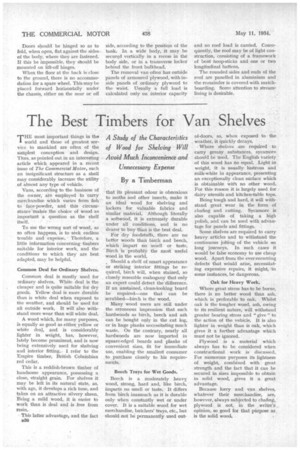The Best Timbers for Van Shelves
Page 48

If you've noticed an error in this article please click here to report it so we can fix it.
A Study of the Characteristks of Wood for Shelving Will Avoid Much Inconvenience and Unnecessary Expense By a Timberman
THE most important things in the world and those of greatest service to mankind are often of the sitiiplest conception and design. Thus, as pointed out in an interesting article which appeared in a recent issue of The Commercial Motor, such an insignificant structure as a shelf may considerably increase the utility of almost any type of vehicle.
Vans, according to the business of the owner, are employed to carry merchandise which varies from fish to face-powder, and this circumstance makes the choice of wood as important a question as the shelf itself.
To use the wrong sort of wood, as so often happens, is to seek endless trouble and expense. Therefore, a little information concerningtimbers suitable for interior work, and the conditions to which they are best adapted, may be helpful, Common Deal for Ordinary Shelves.
Common deal is mostly used for ordinary shelves. White deal is the cheaper and is quite suitable for dry goods. Yellow deal is more durable than is white deal when exposed to the weather, and should be used for all outside work. It will also withstand more wear than will white deal.
A wood which, for many purposes, is equally as good as either, yellow or white deal, and is considerably lighter in weight, has, however, lately become prominent, and is now being extensively used for shelving and interior fitting. I refer to the Empire timber, British Coluthbian red cedar.
This is a reddish-brown timber of handsome appearance, possessing a close, straight grain. For shelves it may be left in its natural state, as, with age, it develops a rich tone, and takes on an attractive silvery sheen. Being a mild wood, it is easier to work than is deal and is free from resin.
This latter advantage, and the fact B30 that its pleasant odour is obnoxious to moths and other insects, make it an ideal wood for shelving and lockers for valuable fabrics and similar material. Although literally a softwOod, it is extremely durable under all conditions, and is no dearer to buy than is the best deal.
For dry foodstuffs, there are no better woods than birch and beech, which impart no smell or taste. Birch is probably the most useful wood in the world.
Should a shelf of smart appearance or striking interior fittings be required, birch will, when stained, so closely resemble mahogany that only an expert could detect the difference. If an unstained, clean-looking board be required—one that can be scrubbed—birch is the wood.
Many wood users are still under the erroneous impression that such hardwoods as birch, beech and ash can be bought only in the cut log, or in huge planks necessitating much waste. On the contrary, nearly all hardwoods are now imported in square-edged boards and planks of convenient sizes, fit for immediate use, enabling the smallest consumer to purchase closely to his requirenients.
Beech Trays for Wet Goods.
Beech is a moderately heavy wood, strong, hard and, like birch, imparts no smell or taste. It differs from birch inasmuch as it is durable only when constantly wet or under cover. It is a suitable wood for wet merchandise, butchers' trays, etc., but should not b6 permanently used out
of-doors, as, when exposed to the weather, it quickly decays.
Whore shelves are required to carry greasy substances, sycamore should be used. The English variety Of this wood has no equal. Light in weight, it is usually lustrous and milk-white in appearance, presenting an exceptionally clean surface which is obtainable with no other wood. For this reason it is largely used for dairy utensils and kitchen-table tops.
Being tough and hard, it will withstand great wear in the form of chafing and cutting_ Sycamore is also capable of taking a high polish, and can be used with advantage for panels and fittings.
Some shelves are required to carry heavy articles and to withstand the continuous jolting of the vehicle on long journeys. In such cases it would be false economy to use cheap wood. Apart from the ever-recurring defects that would arise, necessitating expensive repairs, it might, 'in some instances, be dangerous.
Oak for Heavy Work, Where great stress has to he borne, there is no better wood than ash, which is preferable to oak. Whilst oak is the tougher wood, ash, owing to its resilient nature, will withstand greater bearing stress and " give " to the action of the vehicle. It is also lighter in weight than is oak, which gives it a further advantage which must not be ignored.
Plywood is a material which always has to be considered when constructional work is discussed. For numerous purposes its lightness of weight, combined with great strength and the fact that it can be secured in sizes impossible to obtain in solid wood, gives it a great advantage.
Because lorry and van shelves, whatever their merchandise, are, however, always subjected to chafing, plywood is not, in the writer's opinion, so good for that purpose as is the solid wood.




































































































